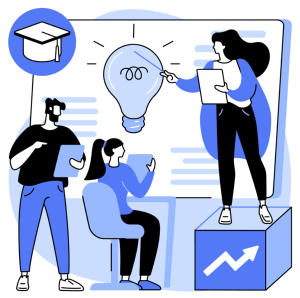For many around the country, the school year has come to a close, and preparations for next year have already begun! AccessATE has published a number of articles and tip sheets about making education accessible for a wide variety of people and disabilities, but here we will take a higher-level perspective and review some best practices for making education accessible for students with disabilities. You might use this as a means of brushing up on the subject or a jumping-off point for ideas on how to expand or improve your existing accessibility efforts, so you can go into the next school year with confidence in your curriculum’s ability to reach everyone effectively.

Universal Design for Learning
Universal Design for Learning, or UDL, is a framework to improve and optimize teaching and learning for all people. This is achieved by ensuring that all educational materials, activities, and assessments accommodate diverse learning needs, which involves providing multiple means of representation, action and expression, and engagement. UDL allows students to access information and demonstrate their knowledge in various ways. For more details, we recommend our partner CAST’s page about UDL, and their UDL guidelines.
Inclusive Curriculum
Developing an inclusive curriculum that acknowledges and addresses the diverse needs of students with disabilities is rarely as difficult as it may sound. It primarily involves incorporating materials, resources, and teaching strategies that cater to different learning styles and abilities. For example, consider providing alternative formats such as audio, braille, or large print materials for students with visual impairments, or ensuring that any presentations and video/audio materials have captions or transcriptions for your deaf/hard-of-hearing students. These measures often have minimal (or sometimes no) cost and may already be available through your institution.
Assistive Technology
Similar to the above, assistive technology tools and devices enhance accessibility to your educational materials, activities, and resources. Assistive technologies include screen readers, speech-to-text software, alternative input devices, and specialized software for physical, sensory, or learning disabilities. Providing access to these technologies empowers students to overcome barriers and actively participate in their education. Again, these accommodations often have little-to-no cost, and your institution may already have some on hand for your students to utilize.
Professional Development
Ongoing professional development and training opportunities for educators and staff are key to maintaining and enhancing their understanding of disabilities, inclusive practices, and assistive technology. Instructors should receive training on how to differentiate instruction, adapt materials, and create accessible learning environments. This ensures that educators are equipped with the knowledge and skills necessary to meet the needs of students with disabilities effectively and without trepidation. Your institution may already have a disability resource center (DRC) that can provide this kind of training or help you find a class or program




 See More Feature Articles
See More Feature Articles